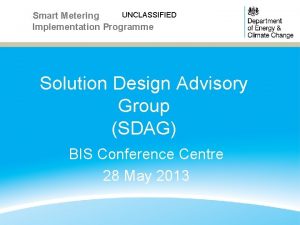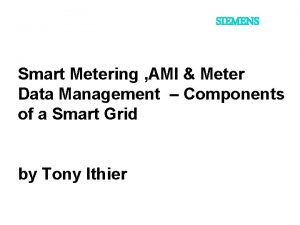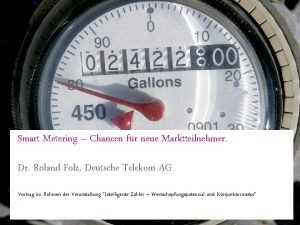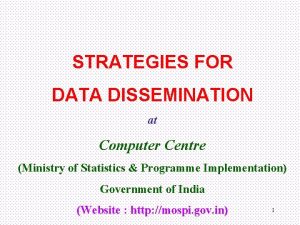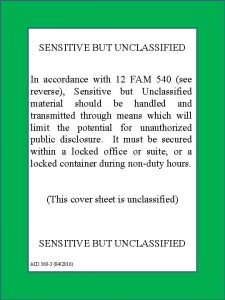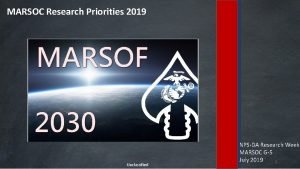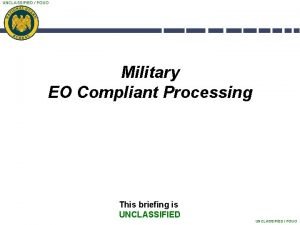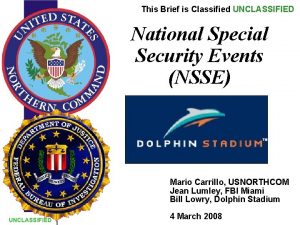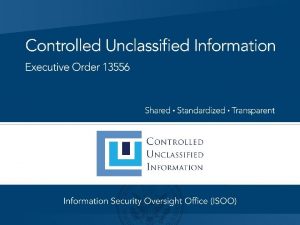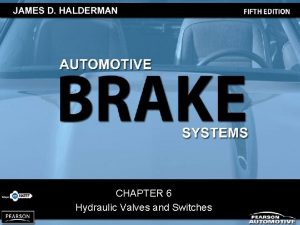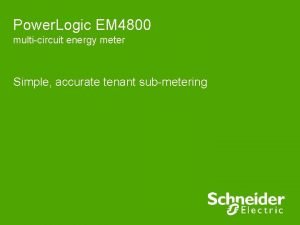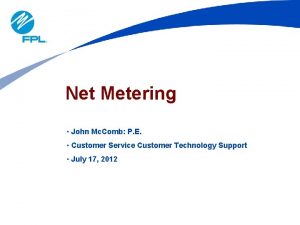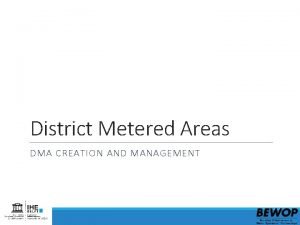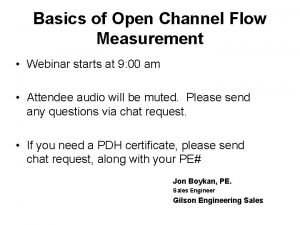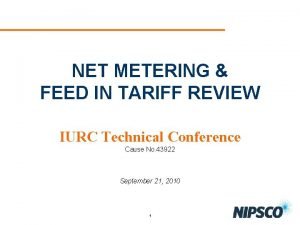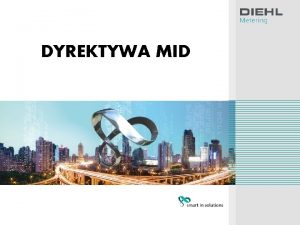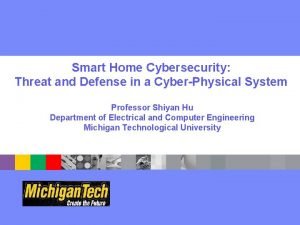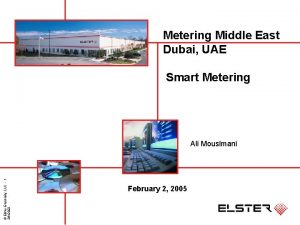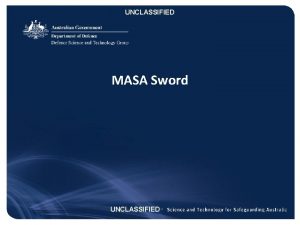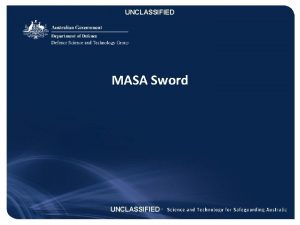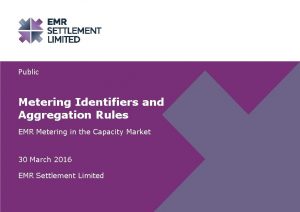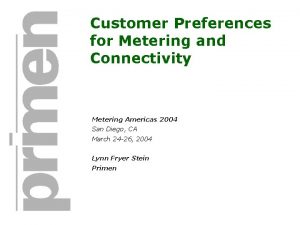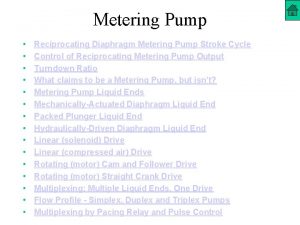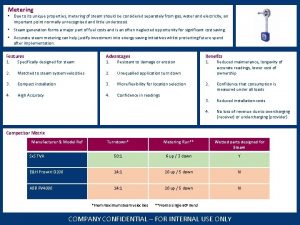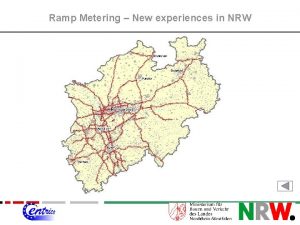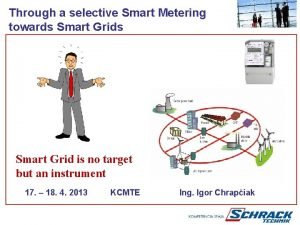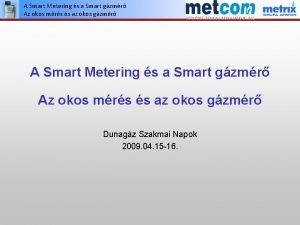UNCLASSIFIED Smart Metering Implementation Programme Solution Design Advisory




































- Slides: 36

UNCLASSIFIED Smart Metering Implementation Programme Solution Design Advisory Group (SDAG) BIS Conference Centre 28 May 2013

Agenda: SDAG #7 BIS Conference Centre 10: 00 Tuesday 28 May 2013 No Time Subject Lead 1 10. 00 – 10. 15 Actions from previous meeting Colin Sawyer 2 10. 15 – 10. 45 Consolidated Issues Log - update Colin Sawyer 3 10. 45 – 11. 30 Role Based Access Control Andy Armstrong 4 11. 30 – 12. 00 Historical Data on IHD Andy Armstrong 5 12. 00 - 12. 45 HAN Options Colin Sawyer/Julian Hughes 6 13. 15 – 14. 00 CAD update Tim Bailey 7 14. 00 - 14. 30 SMETS 2 (1 st iteration) Open Issues Peter Morgan/ Robin Niblock 8 14: 45 – 15: 00 AOB

1. ACTIONS FROM PREVIOUS MEETING Colin Sawyer

Actions

Actions

Actions

2. CONSOLIDATED ISSUE LOG (RAID) - UPDATE Colin Sawyer

Open Issues

3. ROLE BASED ACCESS CONTROL Andy Armstrong

RBAC Flow diagram

Role Base Access Control Architecture Components/Entities Performing Role Based Access • DCC RBAC (DSP) • Determines valid DCC Users for any service requests • Determines valid DCC Users that can request consumer data, i. e. meter readings • Provides access control for pairing of devices including remote service for type 2 pairing requests • Provides access control for valid DCC user requests for type 2 pairing and type 1 whitelisting (i. e. at Install & Commission) • Provides access control at Change of Supply against registration data to validate pending/active registration • Provides data level access control for transformation of non critical DUGC service requests into ‘HAN Ready’ commands, e. g. import or export profile data • Meter RBAC (defined with GB Companion Specification) • Applies access control on every critical command received based upon known roles; Supplier, Network Operator, DSP, Recovery, Root • This is built into the firmware and is based upon security credentials and cryptographic signature • DUGC – present user roles and functionality but the actual access control is applied at the meter for critical commands.

4. HISTORICAL DATA ON IHD Andy Armstrong


5. HAN OPTIONS Colin Sawyer


6. CAD UPDATE Tim Bailey

Objectives of the session Remote Pairing • To update on current position and further work; • To explain the current position regarding what the end-to-end system will provide • To set-out the additional services required to allow a Third Party to use the system to provide a pairing service; • To explain further work which will consider whether additional regulatory intervention is required to ensure that Third Parties are able to provide pairing services.

Objectives of the session Locally-initiated Pairing • To explore the potential benefits from providing a local option in addition to remote option to initiate pairing; • To update on the two options for locally-initiated pairing

Remotely-initiated Pairing

What will the E 2 E system provide? Current proposals. • No changes required to SMETS as remote pairing does not rely on functions of the equipment; • GB Companion Specification will support pairing/unpairing of a CAD following receipt of a valid pairing/unpairing request via the WAN interface; • SEC schedule of core communication services will offer a service to any DCC user to send pairing and unpairing commands to equipment; • DCC user will be subject to Privacy requirements (tbc but e. g. to verify the identity of the energy consumer from whom they have obtained permission to provide a CAD pairing/unpairing service)

What additional services are required to provide a CAD pairing service? – Consumer verification; – Means to allow consumer to provide information to identify themselves, their Comms Hub and their CAD (e. g. portal) – Issue of pairing command via DCC (for remote pairing); – Management of CADs and unpairing; – Support to help consumer navigate Portal; – Support for issues with CADs.

Locally-initiated Pairing

Benefits of a locally-initiated option What will be the attractions of a local option: • At different stages in the rollout – Prior / post DCC go-live; – Prior / post availability of a remote pairing service. • To different types of stakeholder: – Consumers; – CAD providers; – Suppliers.

Locally-initiated options Option 1: Selection of CAD ID from a list on the meter • If Electricity Meter is in a shared space consumer enters Privacy PIN to access restricted menu functions; • Consumer switches on CAD and selects ‘pair CAD’ function/button on Electricity Meter menu. • Menu lists ‘IDs’ all unpaired CADs within range (usually will only be 1) • Consumer selects the ID printed on CAD and selects pair; • Pairing occurs;

Locally-initiated options Option 2: – Short-code entry on Electricity Meter initiates bootstrapping • If Electricity Meter is in a shared space consumer enters Privacy PIN to access restricted menu functions; • Consumer switches on CAD and selects ‘pair CAD’ function/button on Electricity Meter menu; • Customer enters CAD ID via meter interface (4/8 digits depending on level of security required); • Pairing occurs.

7. SMETS 2 (1 ST ITERATION) OPEN ISSUES Peter Morgan/Robin Niblock

Background 1 of 2 When SMETS 2, first iteration, was notified to the EC there were 115 SSAG Comments that were not fully addressed. At the time, these comments were categorised as follows: No of Comments Category GB HAN Companion Specification 65 Future SMETS version 28 Combination of Documents (SMETS, GBHCS, etc. ) 9 Other Document (e. g. CHTS, CPA) 9 Uncategorised 4 Total: 115

Background 2 of 2 The breakdown of outstanding comments was issued to SSAG in January, and DECC undertook to track these and report back to SDAG (Action 5. 04). In addition, a SDAG member carried out some further work following a previous SDAG meeting: • Performing a review of the outstanding comments log for SMETS 2 (1 st iteration) and commenting on this. • Co-ordinating comments from other SDAG members on 11 potential “gaps” in SMETS 2 coverage, to be addressed in the 2 nd iteration. The over-arching concern was a lack of clarity about where specific issues would be “landed”; and that important functionality might be missed.

DECC’s response • We are updating the SMETS 2 issues log to reflect the current position in light of the progress that has been made since January, for example in: – GBH Companion Specification development. – CHTS development and issue. – ISFT Material. – Workshops held with SDAG. • At today’s meeting we will: – Summarise the work to date on progressing the outstanding comments. – Give an initial response to the perceived 11 “gaps” in coverage.

Current Snapshot of Comments Latest analysis of the comments indicate they will be resolved as follows: No of Comments Category GB HAN Companion Specification 44 No Further Action following review 28 Comms Hub Technical Specification 6 Next Version of SMETS 2 3 Later Version of SMETS 1 Technical Architecture 1 Commercial Product Assurance 1 A number of Documents (details in log) 6 Still being worked on [no showstoppers] 25 Total: 115

Potential Gaps identified by SDAG Member 1 of 4 PPMID: Ongoing considerations around capabilities in relation to re-enabling gas and electricity meters. DECC Response: PPMID will form part of the next iteration of SMETS. ICH: Further consideration / justification for a hardwired communication link or PLC connectivity through the ICH port. This will impact upon future interoperability. Potential to reduce HAN traffic supports a case for a hard wired data link, which takes communication between electricity and meter out of the HAN. DECC Response: PLC connectivity excluded from the current version of SMETS 2, and is unlikely to be in the next iteration. HHT: Concern that there still are no detailed rules as to what operatives will be allowed to do on site with an HHT. The industry also needs to come to a consensus view as to whether a HHT will support the meter installation process or whether engineering menus will be provisioned. DECC Response: The Programme’s view is that the HHT is not a Smart Metering device; it is a mechanism for transferring signed DSP commands direct to a meter. As such, the functionality of HHTs is down to industry to define.

Potential Gaps identified by SDAG Member 2 of 4 CAP: The concept appears to have been removed from the E 2 E architecture and SM HAN designs with the suggestion that RBAC will achieve this function. It is accepted that information can be extracted by means of RBAC commands but there is a concern that a CAD requires a CAP as its data gateway leading to concern as to exactly how a CAD will pair and exchange data across the HAN? RBAC has only recently been introduced and requires a clear definition. DECC Response: The concept of a CAP has been removed from the Technical Architecture because it has been replaced with Type 1 and Type 2 devices. CAD: Further to the CAP concerns the high level design of the CAD has yet to be defined. DECC Response: A CAD is a Type 2 device and the mechanism for pairing such devices will be included in the GBCS. ALCS: Acknowledged that ongoing work is making good progress but is yet to be completed. DECC Response: The (HAN Connected) ALCS functionality will form part of the next iteration of SMETS.

Potential Gaps identified by SDAG Member 3 of 4 Co. T: Still concern that the requirement to log daily register reads is set to 14 days. This may give rise to a significant amount of final bills on Co. T to be based on estimates (some estimates suggest 25%). DECC Response: The daily total consumption log allows access to the last 731 days of data, or we could consider changing the daily register reads to something other than 14 days. The latter would need a proposal for a different figure with a cost/benefit analysis; ideally this should be proposed via Energy UK. Firmware Management / Upgrades: Is recognised as a complex area which may require further definition in SMETS or the GB Companion Specification. Clarity is required on how IHD firmware is to be managed. DECC Response: Proposed workshop on Firmware Management should clarify the intended solution. Export: Ensuring that this is documented to enable export MPANs to be input and associated with registers and processes developed to support the requirements of the Export Supplier when not the Import Supplier. DECC Response: The section on MPAN appears to cover this requirement.

Potential Gaps identified by SDAG Member 4 of 4 Security Access Control: This is required at data level. Do we have enough detail of how access control will work to confirm that this can all be undertaken by DCC and there is no specific requirement within the meters? DECC Response: The GBCS will provide a detailed definition of access control at a data level. Additional use of Load Limiting functionality: To date three Suppliers have responded and each support the proposal for Load Limiting as an additional function linked to prepayment services. It is therefore proposed that the requirements should be progressed. This could be undertaken via a small working group within SDAG or by other means as you consider appropriate. There isn't general support for taking forward load management aspects at this point in time. DECC Response: This would be a new addition to SMETS 2 functionality. To progress it we would need a clear definition of the requirements and a cost benefit analysis, ideally proposed via Energy UK.

8. AOB

DATE FOR NEXT MEETING Next Meeting • Meeting #8 – 2 July 2013 BIS Conference Centre, 10 am– 3 pm,
 Smart metering implementation programme
Smart metering implementation programme Metering data management
Metering data management Smart metering telekom
Smart metering telekom Ministry of statistics and programme implementation
Ministry of statistics and programme implementation Unclassified position
Unclassified position Sensitive but unclassified
Sensitive but unclassified Unclassified
Unclassified Unclassified//fouo
Unclassified//fouo Statement of financial position account form
Statement of financial position account form Cui marking example
Cui marking example Unclassified brief
Unclassified brief Nato unclassified
Nato unclassified Unclassified fouo
Unclassified fouo National special security event list
National special security event list Unclassified/fouo
Unclassified/fouo Nato unclassified
Nato unclassified Cui banner marking
Cui banner marking Sage gas meter
Sage gas meter Surefire metering tube chart
Surefire metering tube chart Defective metering valve
Defective metering valve Sage metering
Sage metering Multi circuit metering
Multi circuit metering Fpl net metering agreement
Fpl net metering agreement District meter area design
District meter area design Packaged metering manhole
Packaged metering manhole Ueeneeg171a
Ueeneeg171a Net metering punjab
Net metering punjab Nipsco net metering
Nipsco net metering Dyrektywa mid
Dyrektywa mid Ameren net metering
Ameren net metering Odisha net metering policy
Odisha net metering policy Mt carmel electric net metering
Mt carmel electric net metering Street knowledge vs book knowledge
Street knowledge vs book knowledge One smart man he felt smart
One smart man he felt smart It's not how smart you are it's how you are smart
It's not how smart you are it's how you are smart Future smart answers
Future smart answers It's not how smart you are it's how you are smart
It's not how smart you are it's how you are smart
